In 1933-34, he joined the Winnipeg Monarchs, who were terribly overmatched, scoring just 27 goals in a 14 game schedule, 13 less than the next worst team and 50 less than the first place Kenora Thistles. Despite having the future NHL star Broda in goal, the Monarchs still completed the season with the second worst defense in the MJHL, giving up an average of 4 goals per game, while scoring just under 2. All of this left Broda with a dismal 1-11 record and a 4.25 goals against average, giving little insight into the professional career that was to follow! Even worse, Broda played one game with the Monarchs senior level team, taking the loss after giving up 6 goals.
The 1934-35 statistics only showing Broda playing in 2 games for the Detroit Farm Crest team, which was sponsored by the Farm Crest Bakery of Detroit, winning one and losing one with a 2.00 goals against.
His career took a giant step forward during the 1935-36 season when Broda played in 47 games for the Detroit Olympics of the International Hockey League, winning 26 while losing 18 and tying 3 with 6 shutouts and a 2.10 GAA. In the postseason, Detroit eliminated the other division winner, the Syracuse Stars and then defeated the Windsor Bulldogs in a pair of three game sweeps to capture the championship after Broda allowed just 8 goals in their 6 consecutive victories.
While playing for the Olympics, Broda was spotted by the owner of the Toronto Maple Leafs, Conn Smythe, who was in Detroit scouting a different goaltender. When Broda caught his attention, he contacted Jack Adams of the Detroit Red Wings about acquiring the young goaltender, which he did for the sum of $7,500.
Broda then made his NHL debut in the 1936-37 season and became an instant hit with the Maple Leafs fans due to his outgoing personality. In his first season, he played in 45 games, winning 22 as Toronto qualified for the playoffs.
He would win 24 games in 1937-38 with a 2.56 GAA. While his win total would drop to 19 in 1938-39, his 9 ties and lower 2.15 GAA were enough to allow the Maple Leafs to finish 3rd in the league. In the playoffs, Toronto eliminated the New York Americans 2 games to none and then dispatched the Red Wings 2 games to 1 to qualify for the Stanley Cup Finals, but fell to the Boston Bruins in five.
In 1939-40, he set a new career best with 25 wins and a 2.23 GAA as the Maple Leafs again returned to the Finals after defeating the Chicago Black Hawks and the Red Wings in a pair of 2 game sweeps before falling to the New York Rangers in six.
It all came right for Broda in 1940-41, as he led the league in wins with 28 and won the Vezina Trophy as the Maple Leafs allowed a league low 99 goals against, the only team under 100 for the season.
in 1941-42, Broda was second in the NHL in wins with 27, but more importantly, the second overall Maple Leafs defeated the first place Rangers in six games to advance to the Finals where they met Detroit. The Red Wings won Games 1 and 2 in Toronto 3-2 and 4-2 before putting a stranglehold on the Stanley Cup with a 5-2 win back at home in Game 3.
With Toronto down 2-0 half way through the game, the Maple Leafs fought back and won the game with a goal with seven minutes to play to stay alive for Game 5 where Toronto roared back into contention with a dominating 9-3 win to close the gap to 3 games to 2.
Game 6 in Detroit saw Broda make a Johnny Mowers goal stand up for a 1-0 Maple Leafs victory to tie the series and force an improbable Game 7 back at Maple Leaf Gardens.
A Canadian record 16,218 fans packed the Gardens, the first time a crowd of over 16,000 had ever been reached. Detroit killed off a two man disadvantage in the scoreless first period. Syd Howe got the only goal of the second period for the visiting Red Wings but Sweeney Schriner evened the score after a goal mouth scramble to get Toronto on the scoreboard. Two minutes later, Pete Langelle gave the Maple Leafs their first lead at 2-1. Schriner scored the third goal of the period for Toronto at 16:13 to close out the scoring and completed the incredible four game comeback, something which had never happened before in the 25 years of the NHL.
Broda would play one more season for the Maple Leafs, winning 22 games and finishing with the second best GAA in the NHL at 3.18 for the 1942-43 season until he enlisted in the Canadian Army, spending the next three years away from hockey.
When he was discharged during the 1945-46 season, he rejoined the Maple Leafs and was able to play in 15 of the club's 50 games.
Broda took back his familiar role of Toronto's top goaltender for the 1946-47 season, aided in part by the retirement of his wartime substitute Frank McCool due to issues with stomach ulcers. Back in the saddle, Broda set a new career high with 31 wins after playing in all 60 games for the Maple Leafs in the newly expanded schedule.
During the playoffs, the Red Wings were dispatched in five games before the Maple Leafs won the second Stanley Cup of Broda's career when they defeated the Montreal Canadiens in six games after he only allowed 7 goals over the final five games of the series.
Broda set a career high with 32 wins in 1947-48 and won his second Vezina Trophy with a 2.38 goals against before Toronto won their second consecutive Stanley Cup by beating the Bruins in five before sweeping Detroit in four straight, with Broda getting a shutout in Game 3.
For the 1949-50 season, Toronto sank down to the fourth and final playoff spot with a 22-25-13 record. Broda and the Maple Leafs rose to the challenge and defeated the Bruins in five. They then repeated their sweep of the Red Wings from the season before to win Toronto's third consecutive Stanley Cup and Broda's fourth.
For the 1950-51 season, Broda shared the goaltending duties with Al Rollins, who played in 40 games. Broda would play in 31 games, going 14-11-5, which included winning his 300th on December 20, 1950, making him the first goaltender in NHL history to ever win 300 games in a career.
When it came to the playoffs, Broda ended up seeing action in 8 of the Maple Leafs 10 games. After losing Game 1 of the Semifinals and tying Game 2, Toronto won the next four in a row to send the Bruins packing. The Stanley Cup Finals were a wild affair, as the Maple Leafs and Canadiens played five consecutive overtime games, with Toronto capturing the fifth Stanley Cup of Broda's career as the Maple Leafs prevailed 4 games to 1, winning the final game on Bill Barilko's famous diving goal, his last before vanishing on a fishing trip that summer.
Broda would retire after playing just one game of the 1951-52 season at the age of 37, the oldest player in the league at the time.
Broda would finish with 629 games played with a 302-224-101 record with a career 2.53 goals against average and 62 shutouts. His career playoff record was 60-39 with a 1.98 GAA.
He was the first goaltender to ever win 300 games in a career and would win five Stanley Cups, 2 Vezina Trophies and had his #1 honored by the Maple Leafs and was inducted into the Hockey Hall of Fame in 1967.
Following his playing days, he went into coaching, primarily with the Toronto Marlboros of the Ontario Hockey Association from 1954-55 to 1962-63, which included winning Memorial Cups in 1955 and 1956.
Today's featured jersey is a 1946-47 Toronto Maple Leafs Turk Broda jersey. The Maple Leafs redesigned their logo for the 1938-39 season and wore the same style of jersey all the way through the 1957-58 season until adding a lace-up collar for the 1958-59 season save for the 1945-46 to 1947-48 seasons when the lettering on their leaf logo changed from blue to red for those three seasons, which included a pair of Stanley Cups in 1947 and 1948.
In today's video section, a profile of Broda's career from the Maple Leafs on the occasion of his inclusion in Toronto's Legends Row.



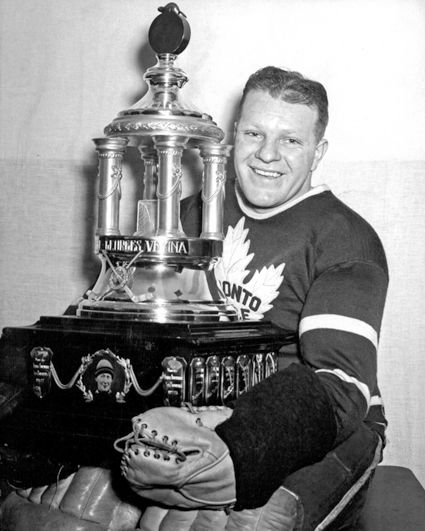
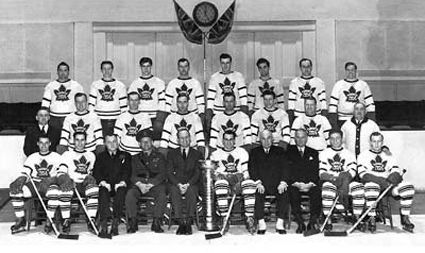
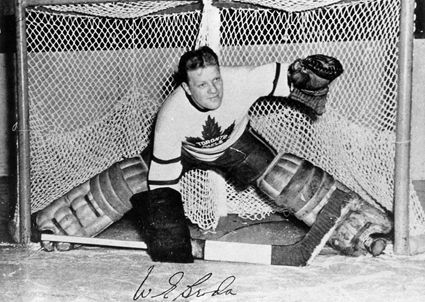
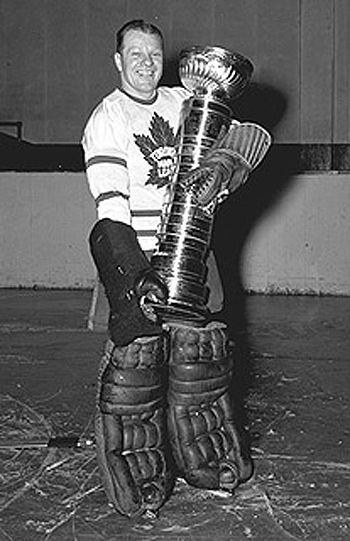
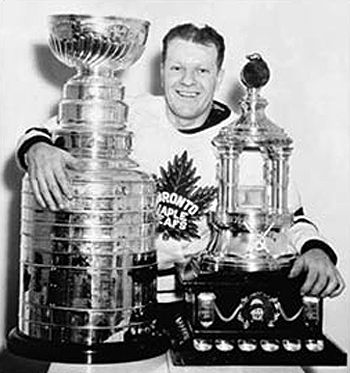
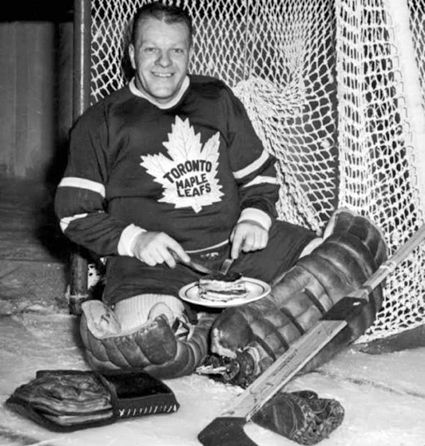
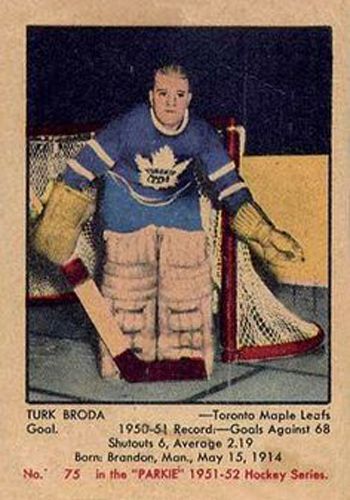
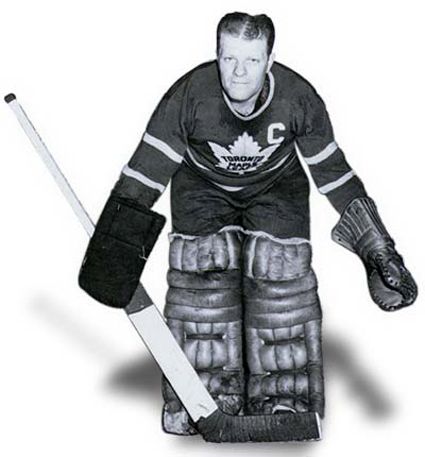











No comments:
Post a Comment
We welcome and encourage genuine comments and corrections from our readers. Please no spam. It will not be approved and never seen.